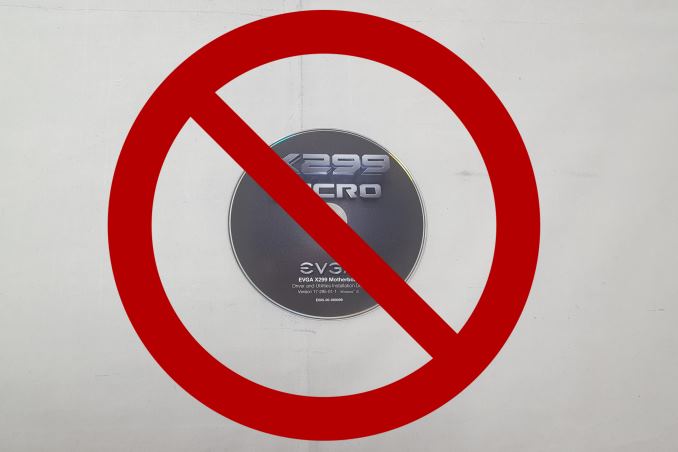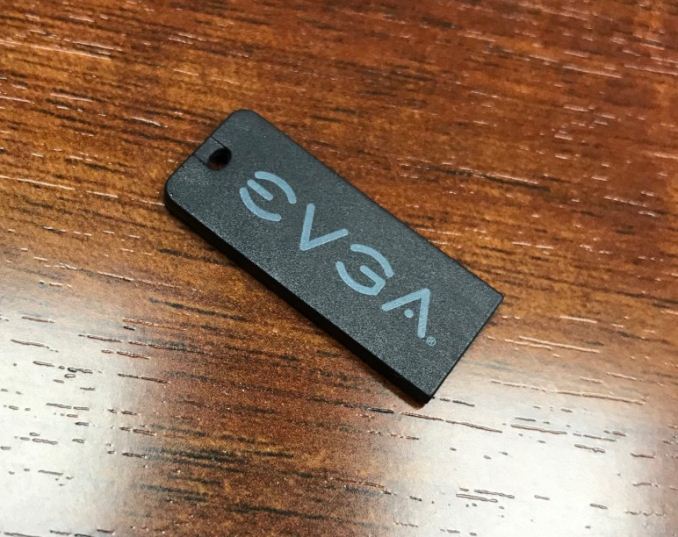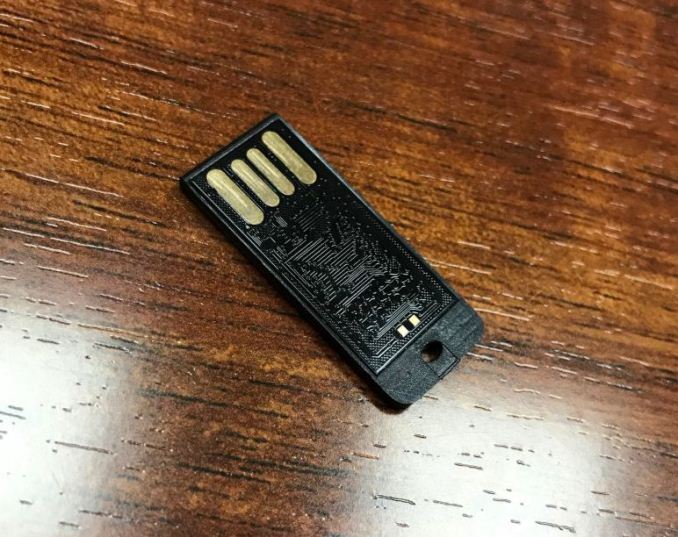EVGA Forgoes Driver DVDs: It’s All About The USB Flash Drive
by Joe Shields on May 18, 2018 11:00 AM EST- Posted in
- Motherboards
- EVGA
- Drivers
- USB

Driver disks of some sort have been part of a PC enthusiast's life as far back as I can remember. Before Windows included drivers, they all came from media included with the motherboard. I first recall them on floppies then once optical media took hold, moved to CDs. As the number of drivers and included software increased in both quantity and size, it outgrew the capacity of CDs and board partners moved to DVDs offering more capacity and faster read speeds. For example, a board partner's driver disk from a Z370 based board weighs in at 6.57GB on the disk, far eclipsing the capacity of a CD (~700MB) and that of a single-sided DVD (4.7 GB).
To that end, yesterday on Twitter, EVGA’s Global Product Management Director Jacob Freeman announced that in the future, EVGA motherboards will not come with driver disks, but USB Flash which contains all the needed drivers and software. This includes H370 based boards now and others moving forward. Instead of a DVD we are used to seeing, EVGA will include a small 8GB USB flash drive with the EVGA logo printed on it instead. While this isn’t a first (a high-end Asus board in the past included one), it certainly is welcome, if only for the quick installation from USB versus CD/DVD installs. The drive is also re-writeable so it can be used for other purposes as well.
Overall, it is good to see EVGA embrace what we feel is the modern, and faster, medium for base driver and software installations, and hope other board partners follow suit. I do wonder a bit about the cost, but even if it adds $1 more, it is worth it (to me). No more whirring from the optical drive to install drivers with H370 and future EVGA motherboards. It’s about time!
Editor's Note: EVGA has confirmed the drive is USB 2.0 based and costs about twenty times more than an optical disk would. Thankfully, EVGA says that significant cost increase will not trickle down to the consumer, which we all appreciate.
I highly doubt that other manufactures will switch to USB drives anytime soon considering the cost is about 20x that of a DVD. Even for a small 8GB USB 2.0 one, but it’s about time someone sets the standard for 2018 🙂 https://t.co/5L1N4trO8q
— Jacob Freeman (@EVGA_JacobF) May 18, 2018












90 Comments
View All Comments
A5 - Friday, May 18, 2018 - link
It's only really needed if you're installing clean on hardware that wasn't out when your OS media was made.Once you get it installed, Windows downloads the latest WHQL stuff if it needs to.
Chugworth - Friday, May 18, 2018 - link
Here's an idea. Good motherboards now should have the ability to download the latest UEFI update directly through the UEFI interface. Why not add the ability in the UEFI interface to download specific drivers to a USB drive? That way they won't have to include any type of driver disk.The bundled drivers are usually outdated by the time you take the product out of the box, and both Windows and Linux are pretty good about loading the needed drivers on their own.
A5 - Friday, May 18, 2018 - link
Yeah, this is probably the ideal solution.UEFI tells you to insert a USB drive, gets the latest signed bundle from the OEM, and puts it on there in the format Windows wants.
Ian Cutress - Friday, May 18, 2018 - link
ASRock has this option, although it requires the BIOS image to have the network driver and support DHCP with no proxy in the mix. Bearing in mind the low single digit percentage of people that are comfortable doing anything in the BIOSCaedenV - Friday, May 18, 2018 - link
Some HP Printers come with built in storage with drivers. You plug the printer into your USB port, it is recognized as a mass storage device, you install the driver, and then it transitions to a printer connection. Whats more; when you upgrade the firmware of the deivce, it also updates these built in drivers... granted, it also locks you out of being able to use 3rd party cartridges... win some loose some?Still, would be sort of neat to get basic network and chipset drivers as a sort of on-board, BIOS managed storage device. Once you had that, you can download the rest of the drivers easily.
esSJae - Friday, May 18, 2018 - link
Make it bootable and include BIOS recovery utilities too!jrs77 - Friday, May 18, 2018 - link
I've not used a driver disk for the last decade. The drivers on the CD/DVD are outdated the moment the box gets shipped to the retailers, so I allways download the newest drivers on a second PC and put them on a USB-stick to have the whole driver-package (chipset, ethernet, sound, GPU, DirectX, .Net, etc, etc ) ready for installation.Mitch89 - Friday, May 18, 2018 - link
Ditto, can’t remember the last time I used a driver CD for anything. I’d generally download the latest graphics driver and network driver (if necessary) on another PC, then let windows find everything else.Thorlord - Friday, May 18, 2018 - link
I love this, Though I only ever really buy Power Supplies from them so i'll never see em. I have to give them credit for making what is really a small but extremely smart change.rocky12345 - Friday, May 18, 2018 - link
Yes about time lets hope more companies start doing this soon. What would be even better is if it self updated itself when you plug it in if the system is connected to the internet and gets the latest drivers from the companies driver page for each product.